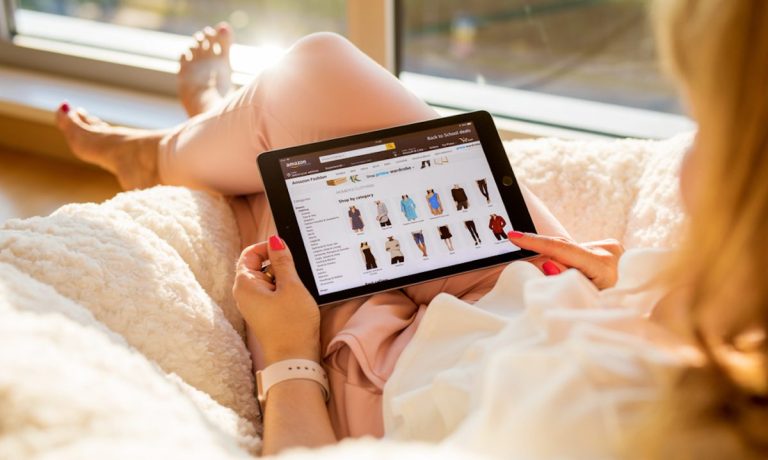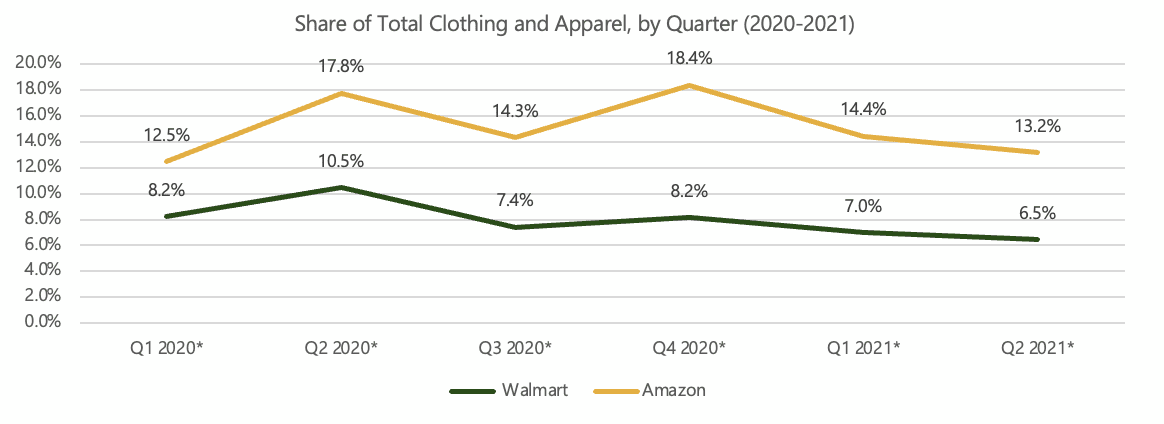Amazon, Walmart See Sliding Shares of Apparel as Style Returns to the Forefront

Both Amazon and Walmart have seen their shares of the clothing and apparel category slowly slip for two quarters in a row, as consumers have begun returning to more stylish and trendy retailers that they favored prior to the pandemic in order to refresh their social wardrobes.
This follows a year in which both retail giants saw spikes in their share of apparel sales as consumers, faced with shuttered stores and an everything-from-home lifestyle, chose comfort and ease over fashion — though Amazon’s five-percentage-point jump at the beginning of the pandemic was more marked than the two-percentage-point increase tallied by Walmart.

Source: PYMNTS Data
In the past six months, though, as vaccination rates have risen and people have returned to seeing friends and family, more fashionable and personal brands have seen a resurgence. Nordstrom, for example, reported 101% year-over-year growth in the second quarter, and Skechers said its second-quarter sales jumped 127% compared to 2020 and 32% compared to 2019. Gap Inc. also saw net sales increase by 29% between May and July compared to 2020 and by 5% versus 2019.
Still, Amazon’s 13% share of the apparel market is noteworthy for a company that 27 years ago started out as a bookseller. Additionally, the eCommerce titan accounts for 48% of all clothing and apparel sales made online, up nearly 8% year over year despite competitors’ efforts to bolster their digital operations.
PYMNTS’ proprietary data are derived from a gross market value standpoint, which tracks the full value of everything sold, not the actual revenue the companies earn. For example, if Amazon sold a $50 set of knives but only booked $5 in revenue, assuming it charged the merchant a typical 10% referral fee, PYMNTS’ use of the former metric provides a more holistic view of where consumers are spending.
Related: AMZN vs. WMT Weekly: Retail Giants Remain in Dead Heat for Top Spot
Getting into Style
Though “fashion” may not be the first thing consumers think of when Amazon or Walmart come to mind, both companies are trying to address their shortcomings. Amazon, for example, launched a luxury marketplace last year, allowing customers to shop collections from Oscar de la Renta, Chufy, Boglioli, Christopher Kane and others. The marketplace was initially invitation only, but has since opened up to the wider public.
See more: Amazon Upgrades Luxury Marketplace With Glossy Ads Aimed at Designers, Customers
And Walmart is looking to partnerships to help bolster its apparel offering. In March, the retailer hired celebrity A-list designer Brandon Maxwell as the creative director for two of its in-house private-label brands. Maxwell is set to oversee four seasonal collections each year for Free Assembly and Scoop, with his influence first being seen in this year’s holiday offerings before full collections drop in the spring.
Walmart also inked a deal to bring the popular Justice brand of kids’ clothing and accessories to roughly half of its U.S. stores and its website ahead of the back-to-school season. All Justice locations were closed in late 2020 after former owner Ascena Retail Group filed for bankruptcy; the brand was purchased by brand management company Bluestar Alliance, which continues to run its eCommerce site.
You may also like: Walmart Grows Fashion Assortment by Teaming With Tween Brand Justice
These partnerships may not be enough to close the gap between Walmart and Amazon, as it’s improbable that consumers are as rabid for Brandon Maxwell and Justice as they are for, say, a Yeezy jacket sold by Gap. But at this point, it’s unlikely that Walmart will overtake Amazon in this category; rather, executives are probably looking to keep the steady growth going and not lose any ground.
Amazon solidly has the upper hand over Walmart in clothing and apparel on an annual basis, reaching nearly 16% market share at the end of last year. Walmart, while still growing its market share each year, had only about half of that. Both retailers, however, could walk away slightly below these shares when the books close on 2021 if the gentle quarterly slide continues.

Source: PYMNTS Data
For Walmart, clothing and apparel sales make up just under 9% of total sales; for Amazon, apparel represents almost 17% of all retail sales.